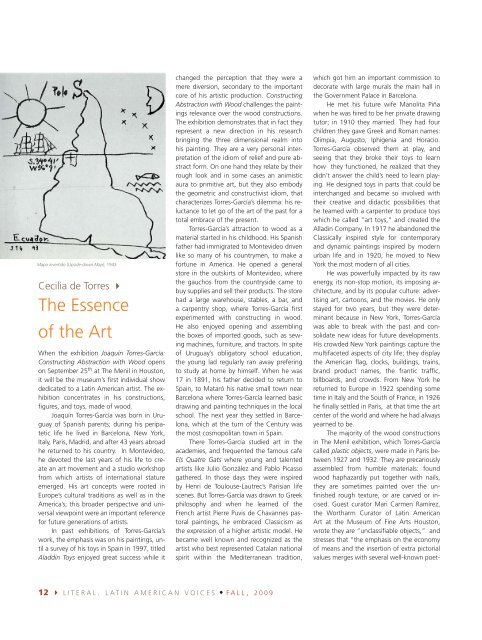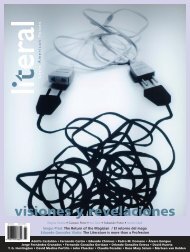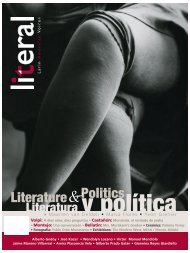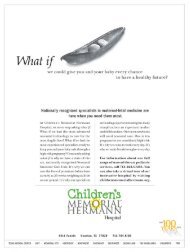Giobany Arévalo > Gabriela Torres Olivares >Anuar Jalife - Literal
Giobany Arévalo > Gabriela Torres Olivares >Anuar Jalife - Literal
Giobany Arévalo > Gabriela Torres Olivares >Anuar Jalife - Literal
Create successful ePaper yourself
Turn your PDF publications into a flip-book with our unique Google optimized e-Paper software.
Mapa invertido (Upside-down Map), 1943<br />
Cecilia de <strong>Torres</strong> <br />
The Essence<br />
of the Art<br />
When the exhibition Joaquín <strong>Torres</strong>-García:<br />
Constructing Abstraction with Wood opens<br />
on September 25 th at The Menil in Houston,<br />
it will be the museum’s fi rst individual show<br />
dedicated to a Latin American artist. The exhibition<br />
concentrates in his constructions,<br />
fi gures, and toys, made of wood.<br />
Joaquín <strong>Torres</strong>-García was born in Uruguay<br />
of Spanish parents; during his peripatetic<br />
life he lived in Barcelona, New York,<br />
Italy, Paris, Madrid, and after 43 years abroad<br />
he returned to his country. In Montevideo,<br />
he devoted the last years of his life to create<br />
an art movement and a studio workshop<br />
from which artists of international stature<br />
emerged. His art concepts were rooted in<br />
Europe’s cultural traditions as well as in the<br />
America’s; this broader perspective and universal<br />
viewpoint were an important reference<br />
for future generations of artists.<br />
In past exhibitions of <strong>Torres</strong>-García’s<br />
work, the emphasis was on his paintings, until<br />
a survey of his toys in Spain in 1997, titled<br />
Aladdin Toys enjoyed great success while it<br />
changed the perception that they were a<br />
mere diversion, secondary to the important<br />
core of his artistic production. Constructing<br />
Abstraction with Wood challenges the paintings<br />
relevance over the wood constructions.<br />
The exhibition demonstrates that in fact they<br />
represent a new direction in his research<br />
bringing the three dimensional realm into<br />
his painting. They are a very personal interpretation<br />
of the idiom of relief and pure abstract<br />
form. On one hand they relate by their<br />
rough look and in some cases an animistic<br />
aura to primitive art, but they also embody<br />
the geometric and constructivist idiom, that<br />
characterizes <strong>Torres</strong>-García’s dilemma: his reluctance<br />
to let go of the art of the past for a<br />
total embrace of the present.<br />
<strong>Torres</strong>-García’s attraction to wood as a<br />
material started in his childhood. His Spanish<br />
father had immigrated to Montevideo driven<br />
like so many of his countrymen, to make a<br />
fortune in America. He opened a general<br />
store in the outskirts of Montevideo, where<br />
the gauchos from the countryside came to<br />
buy supplies and sell their products. The store<br />
had a large warehouse, stables, a bar, and<br />
a carpentry shop, where <strong>Torres</strong>-García fi rst<br />
experimented with constructing in wood.<br />
He also enjoyed opening and assembling<br />
the boxes of imported goods, such as sewing<br />
machines, furniture, and tractors. In spite<br />
of Uruguay’s obligatory school education,<br />
the young lad regularly ran away prefering<br />
to study at home by himself. When he was<br />
17 in 1891, his father decided to return to<br />
Spain, to Mataró his native small town near<br />
Barcelona where <strong>Torres</strong>-García learned basic<br />
drawing and painting techniques in the local<br />
school. The next year they settled in Barcelona,<br />
which at the turn of the Century was<br />
the most cosmopolitan town in Spain.<br />
There <strong>Torres</strong>-García studied art in the<br />
academies, and frequented the famous cafe<br />
Els Quatre Gats where young and talented<br />
artists like Julio González and Pablo Picasso<br />
gathered. In those days they were inspired<br />
by Henri de Toulouse-Lautrec’s Parisian life<br />
scenes. But <strong>Torres</strong>-García was drawn to Greek<br />
philosophy and when he learned of the<br />
French artist Pierre Puvis de Chavannes pastoral<br />
paintings, he embraced Classicism as<br />
the expression of a higher artistic model. He<br />
became well known and recognized as the<br />
artist who best represented Catalan national<br />
spirit within the Mediterranean tradition,<br />
12 LITERAL. LATIN AMERICAN VOICES FALL, 2009<br />
which got him an important commission to<br />
decorate with large murals the main hall in<br />
the Government Palace in Barcelona.<br />
He met his future wife Manolita Piña<br />
when he was hired to be her private drawing<br />
tutor; in 1910 they married. They had four<br />
children they gave Greek and Roman names:<br />
Olimpia, Augusto, Iphigenia and Horacio.<br />
<strong>Torres</strong>-García observed them at play, and<br />
seeing that they broke their toys to learn<br />
how they functioned, he realized that they<br />
didn’t answer the child’s need to learn playing.<br />
He designed toys in parts that could be<br />
interchanged and became so involved with<br />
their creative and didactic possibilities that<br />
he teamed with a carpenter to produce toys<br />
which he called “art toys,” and created the<br />
Alladin Company. In 1917 he abandoned the<br />
Classically inspired style for contemporary<br />
and dynamic paintings inspired by modern<br />
urban life and in 1920, he moved to New<br />
York the most modern of all cities.<br />
He was powerfully impacted by its raw<br />
energy, its non-stop motion, its imposing architecture,<br />
and by its popular culture: advertising<br />
art, cartoons, and the movies. He only<br />
stayed for two years, but they were determinant<br />
because in New York, <strong>Torres</strong>-García<br />
was able to break with the past and consolidate<br />
new ideas for future developments.<br />
His crowded New York paintings capture the<br />
multifaceted aspects of city life; they display<br />
the American fl ag, clocks, buildings, trains,<br />
brand product names, the frantic traffi c,<br />
billboards, and crowds. From New York he<br />
returned to Europe in 1922 spending some<br />
time in Italy and the South of France, in 1926<br />
he fi nally settled in Paris, at that time the art<br />
center of the world and where he had always<br />
yearned to be.<br />
The majority of the wood constructions<br />
in The Menil exhibition, which <strong>Torres</strong>-García<br />
called plastic objects, were made in Paris between<br />
1927 and 1932. They are precariously<br />
assembled from humble materials: found<br />
wood haphazardly put together with nails,<br />
they are sometimes painted over the unfi<br />
nished rough texture, or are carved or incised.<br />
Guest curator Mari Carmen Ramírez,<br />
the Wortharm Curator of Latin American<br />
Art at the Museum of Fine Arts Houston,<br />
wrote they are “unclassifi able objects,” and<br />
stresses that “the emphasis on the economy<br />
of means and the insertion of extra pictorial<br />
values merges with several well-known poet-






